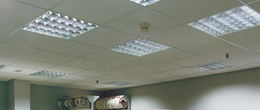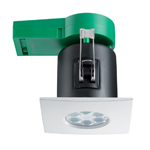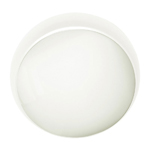The building regulations that govern the introduction of lighting into new homes / premises have been updated. Back in 2013, changes to Part L Building Regulations (Conservation of Fuel and Power) were announced. Originally due to come into force in October of that year, the new measures were finally introduced on April 6th 2014, after a six-month delay.
Part L 2013 Building Regulations relate to England only and are no longer applicable to Wales. They apply to most new buildings and alterations and are a legal requirement. The new regulations affect any work started after 6th April 2014, unless an initial notice, building notice, or full plans application was made before that date. So, what’s new in terms of lighting?
Part L1 (Building regulations for domestic dwellings)
On the domestic front, Part L1 2013 Building Regulations further reduce carbon emissions over the 2010 edition, but lighting requirements are unchanged. They remain as follows:
Internal lighting

- At least 75% of all light fittings in main dwelling spaces should be low energy (this excludes infrequently accessed storage spaces such as cupboards and wardrobes).
- Low energy light fittings must have a luminous efficacy greater than 45 lm/W and a total output exceeding 400 lumens.
- Light fittings consuming less than 5 watts are excluded from the overall count of the total number of light fittings.
External lighting
- Either of two sets of criteria is possible: a 100W maximum lamp capacity with occupancy sensor and photocell (light must stay off when daylight is sufficient) or minimum lamp efficacy of 45 lm/W with a photocell and manual on/off switching.
Part L2 (Building regulations for non-domestic / commercial premises)
This update of the Part L Building Regulations brought profound change to non-domestic lighting requirements. In complying with these regulations, specifiers are now faced with two options:
- The previous luminaire efficacy calculation method, which takes lighting control into account
- The long-awaited LENI system that performs a complex equation to calculate actual energy usage
We’ll outline the features of both systems here:
Luminaire Efficacy Calculation Method
The main advantage of this mode of calculation is that it’s relatively easy to understand. For that reason, it may be favoured for simpler projects. Its two key points are:

- For general office and industrial lighting, the basic Part L luminous efficacy requirement has been increased from 55 to 60 lumens per watt.
- Display lighting requirements remain unchanged, with a 22 lm/W average needed for compliance.
The table below illustrates the allowances made for lighting controls, including dimmer switches and occupancy sensors. An increase in these allowances is introduced, with a new 0.7 control factor and minimum 42 lm/W luminous efficacy.
2013 Control Factors for the Luminaire Efficacy Calculation Method (non-controlled = 60 lm/W)
| Controls | Control Factor | Reduced lm/W efficacy requirement | |
| A | Daylit space with photo-switching with or without override | 0.90 | 54 |
| B | Daylit space with photo-switching with or without override + dimming | 0.85 | 51 |
| C | Unoccupied space with automatic on & off occupancy | 0.90 | 54 |
| D | Unoccupied space with manual on & off occupancy | 0.85 | 51 |
| E | Space not daylit, dimmed for constant illuminance | 0.90 | 54 |
| A + C | 0.80 | 48 | |
| A + D | 0.75 | 45 | |
| B + C | 0.75 | 45 | |
| B + D | 0.70 | 42 | |
| E + C | 0.80 | 48 | |
| E + D | 0.75 | 45 |
LENI (Light Energy Numeric Indicator): the new metric
LENI is the second approach to calculating lighting efficiency, which runs alongside the existing “efficacy method” as an alternative option. Its aim is to predict accurately the actual energy used by a lighting system, taking into account daylight hours, when and how installations are used, parasitic energy consumption, and control factors (occupancy, dimming in response to daylight, and constant illuminance – a calibrated and maintained lux level for each area of a building).
Using a complex formula, LENI measures lighting performance in terms of energy per square metre per year (kWh/m²/year). It allows for a more flexible lighting scheme, where the whole installation is evaluated rather than being anchored by the performance of individual lamps and luminaires. It places a greater emphasis on good lighting design and moves away from a pure numbers game.
Ideal for larger projects
Because of its complexity, the LENI system is likely to be used more for larger lighting projects, where specialist designers will often be employed. It’s worth considering, however, that lighting installations created by specialist designers typically consume 30% less energy than those devised by non-experts.
The LENI index is a core part of the BS EN 15193 Standard (Energy Requirements for Lighting). It is outlined in full detail on Page 70 of the HM Government Non-Domestic Building Services Compliance Guide (PDF).
Don’t worry – help is at hand
 If this looks a little complicated, don’t worry. You don’t have to be a mathematical genius to get to grips with LENI. There are various free lighting design programs that incorporate a LENI calculator. Two examples are: DIALux and RELUX. Also, if you have no fear of spreadsheets, Thorn Lighting provides a LENI formulae template.
If this looks a little complicated, don’t worry. You don’t have to be a mathematical genius to get to grips with LENI. There are various free lighting design programs that incorporate a LENI calculator. Two examples are: DIALux and RELUX. Also, if you have no fear of spreadsheets, Thorn Lighting provides a LENI formulae template.
Easy Part L compliance with Lyco
 Whether you’re a builder, specifier, or designer, Lyco stocks a wide range of products to help you meet Part L lighting requirements.
Whether you’re a builder, specifier, or designer, Lyco stocks a wide range of products to help you meet Part L lighting requirements.
Many products deliver a performance that exceeds basic Part L efficacy requirements while also offering elements of control.

Lyco also stocks a selection of Varilight dimmer switches, which are revered in the lighting industry for their reliable LED dimming performance.
However simple or sophisticated your needs, we’ll help you find the right product(s) for a satisfying lighting solution. Feel free to give us a call if you need any further guidance.
Why not take a look at our Lighting for New Build series of articles?
Alternatively, for more inspiration and advice try our Lighting Advice section.

Andrew Evangelidis Head of Buying
Andrew is an experienced buying professional who takes an entrepreneurial approach to identify new lighting solutions and ensure Lyco have first-to-market ranges for our customers. Having previously worked for well known brands such as Wickes, Carphone Warehouse and Toys R Us, Andrew has now turned his hand to sourcing commercial lighting and ensure our customers receive top brand quality products at marketing leading prices. He manages a team of commercial and decorative buyers who travel the world finding new products that our customers don’t even know they need yet.


